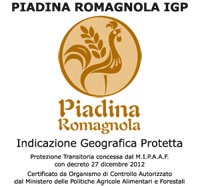In 2014, the traditional “piadina romagnola” received the PGI certification (protected geographic identification), which sets precise limits in production and recipes of this special bread. We are a traditional festival and reenactement in Romagna and we serve this dish to all our visitors. According to “Cibo360” http://bit.ly/Piadina1 , the fight to get from the EU the PGI certification started in 2003 and ended about 10 years later. Producers from Ravenna, Forlì, Cesena, Rimini and Imola wanted to certificate where and how this bread is prepared, in order to avoid confusion with similar preparations, made in different regions and sold in supermarkets using the same name. They also fixed recipe and dimensions: wheat flour, water, salt, olive oil or lard; between 15 – 25 cm bright, 4 - 8 mm high, and 23 – 30 cm bright, 3 mm high. P logo from cibo360.it On the other hand, “Ravenna e Dintorni” tells us about origins and history of this preparation ( http://bit.l...

